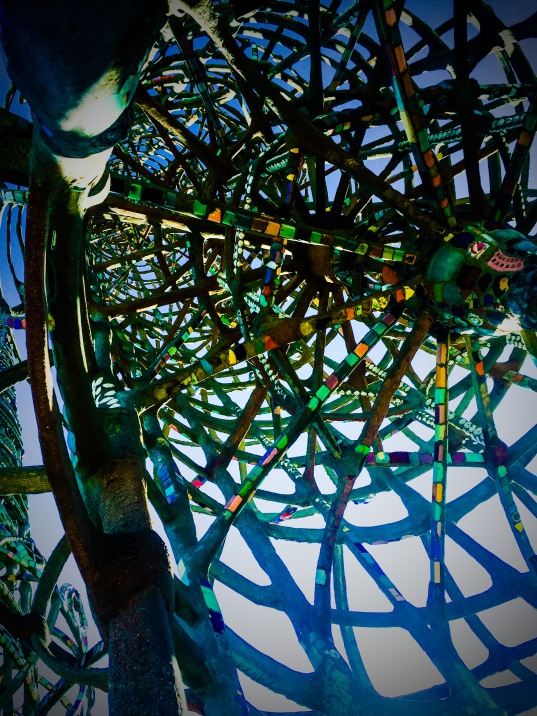
“Good, good, good, or bad, bad, bad.. You be half good and half no good, well, that’s no good. “You got to do something they never got ‘em in the world… “ “I’m gonna make a tower, different than Galileo. . . I want to do something.” “I was one of the bad men in the United States” “I build the tower the people like. . . everybody come.” ~ Simon Rodia, creator of Watts Towers
Sam was blinded by his artistic vision. Wearing sagging, worn-out overalls, and a dusty brimmed hat, to keep the L.A. sun out of his eyes as he worked, the artist maintained an obsessive dedication to his art. For 33 years, neighbors grew more and more suspicious of his sanity. They watched him work tirelessly on a solo project, constructing massive towers of metal and concrete. The artist lived in a modest residence, within these concrete boundaries.
The southern California light shone brilliantly through shattered pieces of glass, as he considered their exact placement. The towers were embellished with these glittering bits and pieces of what others might consider debris. Shells, rocks, broken tile and table crockery were collected from roadsides, beaches and railway beds. Jagged pieces of discarded 7-up bottles cast a green glow as they filtered the harsh sun.
The artist responsible for “Nuestro Pueblo” spoke in a heavy Italian accent, through teeth that were no longer there. An uneducated Italian immigrant, he was barely 5 feet tall; he was a self-taught artist, a working-class tile setter and construction worker. He had no assistants. There was no scaffolding. What Simon Rodia referred to as “Our Town,” suggesting community living, came to be known as The Watts Towers of Simon Rodia, named for the community it was a part of, and the man responsible for the work.

Arial photos reveal an imposing structure, made of bent steel and hardened concrete, jutting almost one hundred feet into the sky, above a south central residential community, on the outskirts of L.A. When seen from above, the thin wedge of southern California property resembles the bow of a ship, narrowing at one end. Three towers give the impression of a ship’s sails. Our tour guide explained that the entire structure, an elaborate complex that once included the artist’s living space, was built to follow the direction of the sun.
The repurposed rebar used to build the towers was bent by being wedged under railroad tracks, then shaped by manual force, exerted by the artist himself. The smallest of the three towers was sort of the “practice” tower, testing out Rodia’s technique. The tall, thin 2nd tower, proved the structural integrity of the construction, so that the artist could take risks, dreaming bigger, with each of his artistic experiments. The bars were tied together with wire, wrapped in wire mesh, then painstakingly covered with cement. Each step was completed by Rodia himself.
There was no money to hire assistants, or fellow artists, to work by his side. If there had been funds, Rodia wouldn’t have hired extra help. The short documentary that runs in the arts center contains footage of him explaining that they wouldn’t know what to do. He chuckles, adding that he hardly knew what to do, much of the time.
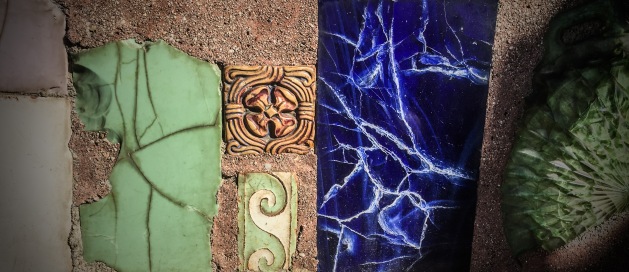
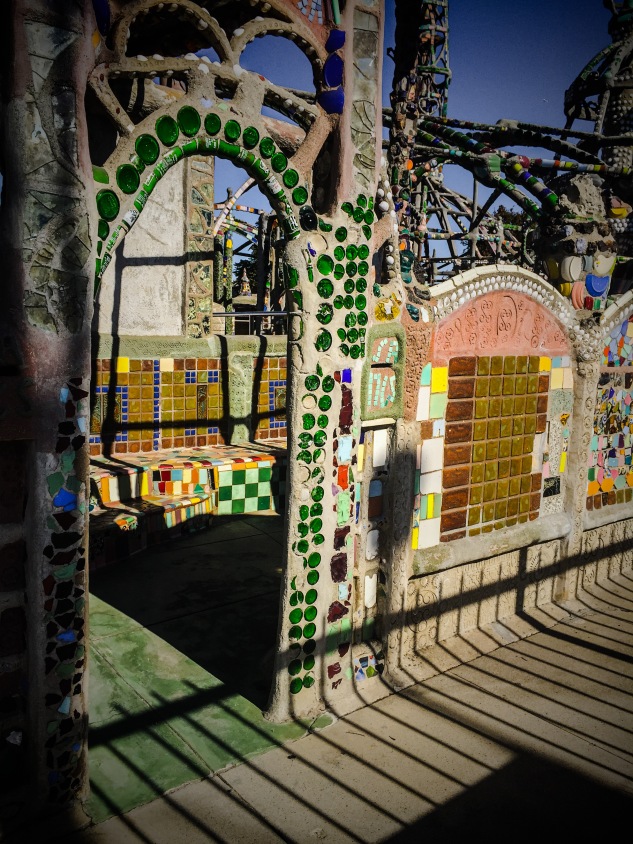
You’d imagine that you’d see the Watts Towers from miles and miles away, given their towering height. Following our GPS, then running into neighborhood construction projects, with closed and one-way streets, we did not see the towers until we turned a corner and they were right there in front of us. It surprised me that such an immense structure could appear suddenly, breaking the landscape. The tallest, widest, strongest, and most complex of the three towers stands 99 ½ ft. tall.
On either side of the towers are tightly-packed L.A. residences, some in need of the most basic of repairs. The 2010 documentary The Towers describes the scene as “shacks, trailers and weather beaten bungalows,” a neighborhood into which this “builder of defiant towers” moved in.
Powerlines slice through the old neighborhood, making it difficult to get an unobstructed view of the towers. A stray dog stands in the street, quietly challenging us, proudly defending his home territory; he’s scrawny, and begging for food, while remaining suspicious of our intentions. Around the time Rodia was there, the neighborhood consisted of Mexican ranches, and then an immigrant population moved in, followed by an influx of black residents, all very segregated.
Our tour guide talks to us about the race riots of Aug 1965, during which Watts Towers remained an isolated, protected space. It was respected enough, for its history, cultural significance, and sense of community, to be spared from the vandalism and destruction that was going on around the neighborhood. Over 5 days of riots, the violence left 34 dead, 1,032 injured, nearly 4,000 arrested, and $40 milion in property damage.
“In the predominantly black Watts neighborhood of Los Angeles, racial tension reaches a breaking point after two white policemen scuffle with a black motorist suspected of drunken driving. A crowd of spectators gathered… to watch the arrest and soon grew angry by what they believed to be yet another incident of racially motivated abuse by the police. A riot soon began, spurred on by residents of Watts who were embittered after years of economic and political isolation. The rioters eventually ranged over a 50-square-mile area of South Central Los Angeles, looting stores, torching buildings, and beating whites as snipers fired at police and firefighters. Finally, with the assistance of thousands of National Guardsmen, order was restored on August 16.” (History.com)
On our tour of the towers, during which we were encouraged to photograph, but instructed not to touch the delicate structures, our attention is drawn to the materials used, to lend texture and vitality to the towers. The discarded, the unwanted, was gathered up and used to embellish these grand structures, repurposed as something beautiful. Tools as mundane and utilitarian as an old metal grill, an out of service rug beater, and a detached faucet handle are pressed into the wet concrete, leaving patterned impressions.
Perhaps the participants in the riots felt just as discarded, unwanted by the rest of society, and the unmolested towers represented a place of community, and of beauty, that they could not find elsewhere, on the poor streets, on the outskirts of Los Angeles.
Just 10 years ago, the segregation persists; the area was reported to be “moderately diverse,” with the percentage of black and Latino people being high for the county. The LA Times reports the demographic of the 2.12 square mile community, known as Watts, as follows: 61.6% Latino, 37.1% Black, 0.5% White, 0.5% other, 0.2% Asian. Median income is around $25,000 and less than 3% of residents have a four-year degree. The rate of single parent households is high, and so is the average household size.
On the day I was there, the Watts Towers Arts Center was under the care of community members who had benefited from the cultural and art programs at the center, in years past. Our tour guide grew up in the neighborhood, and his mother is still a resident there. The folks at the front desk, taking admission and running the gift counter, seemed to be buried in stacks office work, to keep the center functioning, but they were extremely generous with their time.
They told us how the center had impacted their lives, when they were younger, and looking for direction, and community support. Artists would gather, at all hours, to do their work. Before there were formal youth programs, groups came together to share stories, create music, and find inspiration through each other’s creative vision.
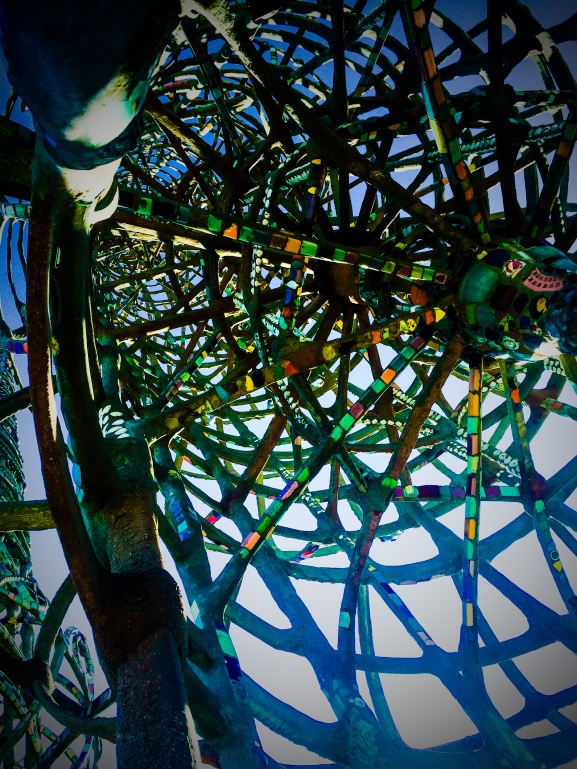
They joked with us about the appearance of turtles & tortoises outside, in the community garden. They couldn’t pinpoint exactly how the turtle sanctuary had grown from 1 or 2 “rescues,” to 5 or ten, and now an entire enclosure dedicated to their preservation. These were people that the center had a lasting impact on. They were happy to dedicate their time now, to keep it profitable, and funded, so that it could continue to provide services to the community, and especially the children in the area.
Youth Students at the Watts Towers Arts Center Campus are expected to work 10 hours per school year. They work in the garden, harvesting and providing care to the plants and animals, including the turtles and tortoises. Classes are offered in Shadow Puppet Theater, Piano, Tai Chi Chuan, and Animation.
The 36th Annual Watts Towers Day of the Drum Festival took place this year, as it always does, during the last weekend in September. It was a day full of culture, art, song, and storytelling. “Rhythm Roulette” was advertised on the Watts Towers website, as “a rhythmic soulful infusion of musical elements, past, present and future.” The weekend continued with the 41st Annual Simon Rodia Watts Towers Jazz Festival, a tribute to great artists and music, jazz and poetry. Activities went on all day, including children’s activities, and guided tours of the Watts Towers of Simon Rodia went on throughout the day.
“If a man who has not labeled himself an artist happens to produce a work of art, he is likely to cause a lot of confusion and inconvenience.” (Calvin Trillin in the New Yorker in 1965). The correspondent from New York explained that Rodia had “constructed a dream-like complex of openwork towers . . . and encrusted them with a sparkling mosaic, composed mainly of what had once been refuse.”
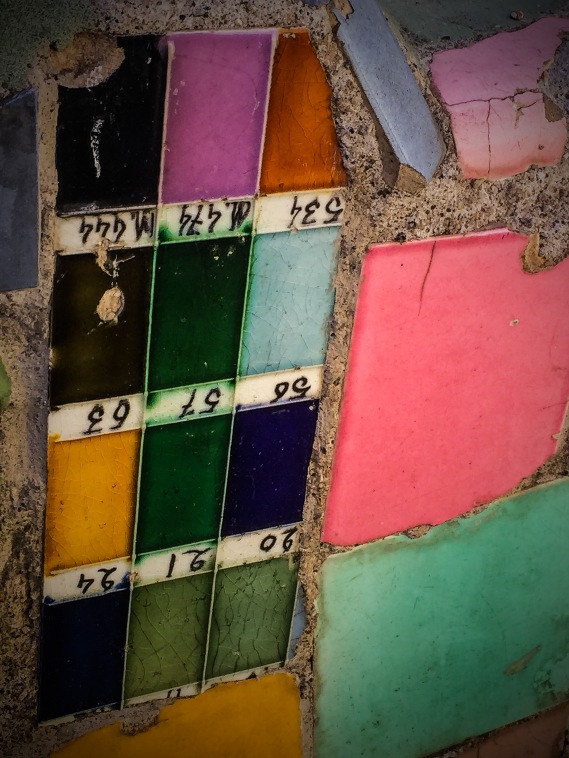
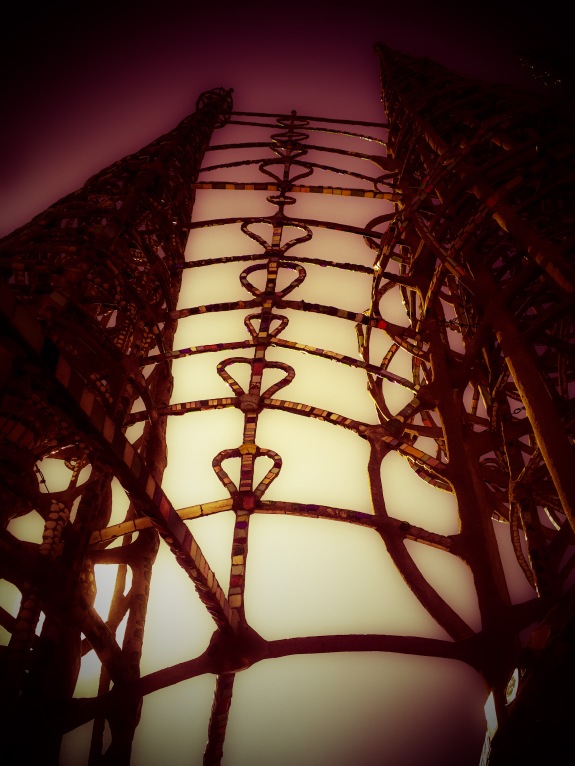
The 17 overall structures that comprise Watts Towers are now owned by the State of California and managed by the City of Los Angeles. They are a National Historic Landmark, and the Los Angeles County Museum of Art (LACMA) has stepped in to restore and preserve their integrity. We’re told by the tour guide that there’s something of a restoration stalemate, with disagreements about what ought to be done with the place, and to what extent it should be kept in its original state.
We are lucky to have seen the towers near the end of 2017. Tours will cease in January of 2018, and the towers will be engulfed in scaffolding, as a 3 year restoration project commences.
Preservation efforts by Los Angeles County Museum of Art (LACMA): “In October 2010 LACMA entered into a partnership with the City of Los Angeles Department of Cultural Affairs to oversee the day-to-day care and maintenance of Watts Towers and to develop a comprehensive plan for its long term preservation. Daily maintenance involves monitoring the loss of decorative elements and the movement of cracks and fissures; monitoring the movement of the Towers and foundations and the environmental conditions at the site; and documenting the state of preservation and structural stability of the individual sculptures.” http://www.lacma.org/art/exhibition/watts-towers
An education center / art gallery is associated with the arts center. This fall, the Noah Purifoy & Charles Mingus Galleries, located at the Watts Towers Arts Center Campus presented Sankofa by La Monte Westmoreland (Rosie Lee Hooks, Curator). The quote on the promotional poster reads: “The wisdom of learning from the past to build for the future.”
Sankofa means “return and get it.” The subject of the exhibit keeps the racial tensions of the area, of our society at large, in the foreground. “Three Sisters” (2011) is a collage piece that juxtaposes Aunt Jemima, a Geisha, and the Girl with the Pearl Earring.
Other striking images, incorporated into the exhibit include:
Uncle Ben’s Instant Brown Rice
Cream of Wheat
Blackie Toothpaste
Black Kabuki
Black Samurai
“Caution: Illegal Immigrants” sign
If this is an example of “outsider art, then it fits right in on Rodia’s property. Rodia himself was such an outsider. Never quite assimilating into modern industrial America, Rodia wanted to create something bigger than himself, to share in that world.
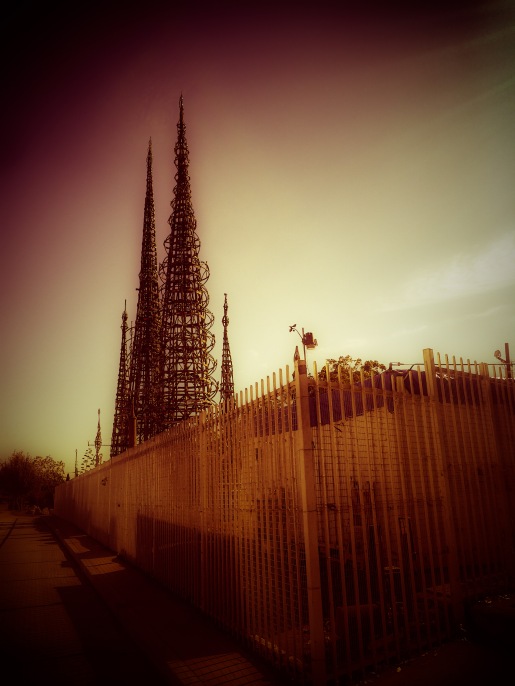
In Rodia’s words: “Good, good, good, or bad, bad, bad.. You be half good and half no good, well, that’s no good. “You got to do something they never got ‘em in the world…” “I’m gonna make a tower, different than Galileo. . . I want to do something.” “I was one of the bad men in the United States” “I build the tower the people like. . . everybody come.”
A sign hanging inside the arts center sums up Rodia’s life, in a few short paragraphs. It tells visitors that Simon Rodia came to the United States in the early 1890s, as a young man, born in Italy around 1875. His property in Southern California was purchased in the 1920s, and Sam began work on the towers the next year, settling in for over 30 years. In 1954 he stopped his work on the Towers, deeded the property to a neighbor, and moved away, never to return.
“Rodia came to America, pulled himself out of alcoholism and became maniacally driven to create something big. A gently moving piece of work, this doc demonstrates how sometimes, against all odds, one person can leave a mark on the world.” (20 Best Documentaries About Los Angeles)
The preview for the 2006 documentary I Build the Tower begins with black and white footage of Rodia, dressed in working clothes, waving viewers in, inviting them into his creation. The music is grand, but also ominous, a kind of march, bringing you along into Rodia’s world. . . The preview ends with more footage, of an Italian immigrant’s kiss, and a wave.
Join me on my next adventure,
~ Kat
Related Links:
The Watts Towers Art Center: http://www.wattstowers.us/
Watts Towers Art Center (official): https://www.wattstowers.org/tours
I Build the Tower (2006): http://www.ibuildthetower.com/
20 Best Documentaries about Los Angeles: https://nonfics.com/the-20-best-documentaries-about-los-angeles-f9b8cfd29ee2
The Towers (LACMA) 1957 film: http://www.lacma.org/video/towers
LACMA’s Restoration of Watts Towers: http://www.lacma.org/art/exhibition/watts-towers
West African Wisdom: Adinkra Symbols & Meanings: Sankofa: http://www.adinkra.org/htmls/adinkra/sank.htm
History.com: Watts Riots of 1965: http://www.history.com/this-day-in-history/watts-riot-begins
LA Times, Watts Demographic: http://maps.latimes.com/neighborhoods/neighborhood/watts/
Sankofa: West African Wisdom: Adinkra Symbols & Meanings: http://www.adinkra.org/htmls/adinkra/sank.htm







Quite a life story to read and visualize! Beautiful work…..accomplishments!
BLOG ON!
LikeLike